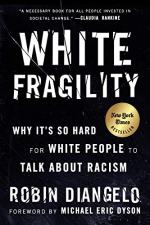
|
| Name: _________________________ | Period: ___________________ |
This test consists of 15 multiple choice questions and 5 short answer questions.
Multiple Choice Questions
1. What does Diangelo say Mr. Roberts and his colleague were unable to do?
(a) Swallow their pride.
(b) Separate intention from impact.
(c) See color.
(d) Be nice to kids.
2. How do white people generally feel when they are challenged on their racism, according to Diangelo?
(a) Confused.
(b) Adored.
(c) Accused.
(d) Loved.
3. What does Diangelo ask white people to consider about racism?
(a) That they try to make friends with people of color.
(b) That they try to be less white.
(c) That it is a matter of life and death.
(d) That it only matters if they make it an issue.
4. In Chapter 7, what did the accused teachers fail to do, according to Diangelo?
(a) Recognize their faults and consider the students' perspective.
(b) Take a racism workshop.
(c) Complain about what had happened.
(d) Apologize to the students.
5. According to Diangelo, white fragility can be understood as what?
(a) Something only bad white people exhibit.
(b) Fine in moderation.
(c) The sociology of dominance.
(d) A natural part of life.
6. How did Diangelo push back against Eva?
(a) She asked about how her experience living in the US for 20 years impacted her understanding of racism.
(b) She told Eva to leave.
(c) She did not push back.
(d) She asked Eva if she had ever seen films or read books.
7. At what point in her life did Diangelo experience a challenge to her racial identity?
(a) When she was a baby.
(b) When she was a child.
(c) When she was a full adult.
(d) When she was a teenager.
8. Why do people cry white tears?
(a) They feel attacked.
(b) They feel loved.
(c) They feel sadness.
(d) They feel empathy.
9. Who is known for crying white tears the most?
(a) Black men.
(b) White men.
(c) Black women.
(d) White women.
10. What is one function of white fragility, according to Diangelo?
(a) To protect white privilege.
(b) To bully others.
(c) To love others.
(d) To protect people of color.
11. How did a female teacher who was Mr. Robert's colleague refer to one of her black students?
(a) "Sweetie."
(b) "Girl."
(c) "Honey."
(d) "Boy."
12. What did one unhappy program participant email Diangelo that she would rather talk about than race?
(a) Gender.
(b) Movies.
(c) Class.
(d) Sex.
13. What happens in Diangelo's workshops when she points out racism that is happening in the room?
(a) Only a few people care.
(b) Nothing happens.
(c) White fragility errupts.
(d) Only the people of color care.
14. What are three key aspects to habitus that are relevant to white fragility?
(a) Field, Guilt, and Corporation.
(b) Field, Habitus, and Captial.
(c) Field, Habitus, and Crenshaw.
(d) Field, Homostasis, and Captial.
15. What does Diangelo write is one very common claim white people use when challenged about racism?
(a) "I know people of color."
(b) "I love all races."
(c) "I listen to all kinds of music."
(d) "I don't see color."
Short Answer Questions
1. Who does Diangelo write that white fragility punishes in racial discourse?
2. Who is Mr. Roberts?
3. What do white people often want to do before they engage in racial discourse, according to Diangelo?
4. How did Diangelo react when confronted by her black colleague on her racism?
5. Who does the chain of self-defense blame for white people's discomfort about racism, according to Diangelo?
|
This section contains 615 words (approx. 3 pages at 300 words per page) |

|




